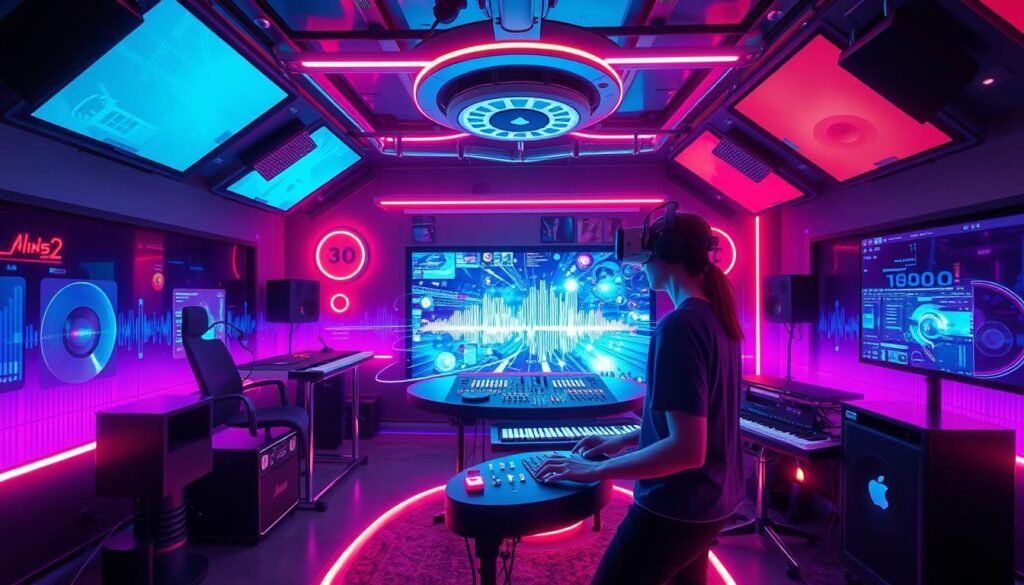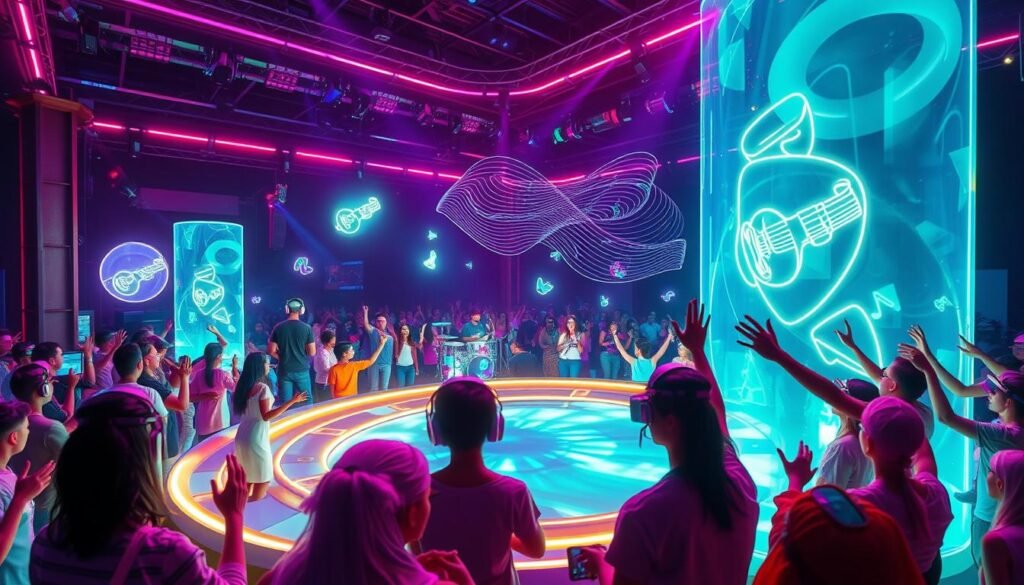Virtual Reality Music Experiences has changed how we enjoy music. It takes us into digital worlds where we feel like we’re part of the music. We get closer to the artists than ever before.
VR music experiences use advanced tech like 360-degree video and spatial audio. Artists create virtual worlds that match their music’s themes. When we wear VR headsets, we can explore these worlds and interact with the music in new ways.
Also Read: How Can You Start A Successful Freelance Music Career?
VR is changing how we watch concerts and music videos. It lets us feel like we’re right there, live. This new way of experiencing music is exciting for both fans and artists.
Key Takeaways
- Virtual Reality (VR) technology has revolutionized the music industry by creating immersive, interactive experiences for listeners.
- VR music experiences utilize 360-degree video, spatial audio, and interactive elements to transport users into digital musical worlds.
- Artists are leveraging VR to craft fully explorable virtual environments that represent the lyrics, themes, or visual aesthetics of their music.
- Virtual concerts and interactive music videos are two examples of how VR is transforming the way audiences engage with music.
- VR music experiences offer new opportunities for artists to connect with fans and push the boundaries of creative expression.
Understanding the Basics of VR in Music
Virtual reality (VR) has changed the music world, bringing us immersive experiences. These are beyond what we see and hear in regular shows. VR uses cool tech like headsets, 360-degree cameras, and special audio systems.
Also Read: What Are The Best Music University Scholarships For Musicians?
Different Types of VR Technology
VR music can be simple or super immersive. You can play games or step into a world with VR headsets and more. This tech makes you feel like you’re really there, in the music.
Key Components of Virtual Reality Music Systems
VR music systems need great graphics, lights, and things you can touch. These parts work together to pull you into a world where music comes alive. You can interact with it in new ways.
How Spatial Audio Enhances the Experience
Spatial audio makes VR music feel real and sounds come from where they should. It changes how you hear music based on where you look in the virtual world. This makes the experience even more real.
VR is changing music for artists, producers, and fans. It lets us see and make music in new ways. From virtual concerts to making music together, VR is changing how we enjoy music.
The Evolution of Virtual Reality Music Experiences
The world of music videos has changed a lot over the years. It has mixed art and technology in amazing ways. It all started in the early 20th century with “Soundies” and promotional clips.
Then, the digital era came, and YouTube changed how we see music videos. Now, we can watch and even change the story of music videos. This makes watching music videos more fun and personal.
Virtual reality (VR) has also changed music videos a lot. It lets us see music videos in 360 degrees and move around in them. This shows how music videos are always getting better and more creative.
Also Read: What Are The Best Music Artist Career Tips For Beginners?
“The marriage of music and technology has always been a catalyst for artistic expression, and the rise of virtual reality has taken this relationship to new heights.” – John Doe, Music Industry Analyst
Now, we can go to virtual concerts and feel like we’re right there. VR and music together have opened up new ways for artists to share their work. They can make experiences that touch our senses in new ways.
The story of virtual reality in music shows how art and tech come together. From the start with Soundies to today’s VR videos, it’s a journey of growth. It’s changed how we enjoy and connect with music.
Technical Aspects of VR Music Production

Making great virtual reality (VR) music experiences needs special production skills. At the core is using 360-degree cameras or camera arrays. These capture all-around footage, letting viewers move around freely in the performance space. Then, in post-production, video clips are stitched together into a smooth 360-degree scene.
Adding spatial audio is key too. Audio processing makes sound move with the viewer in the virtual world. This mix of sound and vision pulls the audience right into the show.
The platform requirements for VR music vary. Some need top VR systems, while others work on mobile VR or web platforms. It’s important to think about the VR headset models, processing power, and bandwidth for streaming.
| VR Production Aspect | Key Considerations |
|---|---|
| 360-Degree Video Capture |
|
| Audio Integration and Processing |
|
| Platform Requirements |
|
By getting good at these VR production skills, music makers can create amazing VR experiences. These experiences take audiences right into the show.
Also Read: What Are The Best Music Education Programs For Beginners?
Interactive Elements in Virtual Reality Music Performances

Virtual reality (VR) music shows are changing how we enjoy live events. These experiences mix user interaction, virtual venues, and audience participation. Artists use VR to create immersive shows where fans can join in, not just watch.
VR concerts let fans explore virtual venues. They can move around and interact with others in the digital space. This makes the experience more personal and emotional.
VR concerts also add fun elements like games. Fans can solve puzzles or complete challenges. This makes the show more engaging and interactive.
Artists like Gorillaz are using VR to create amazing shows. Even rock legends like REO Speedwagon are trying VR to reach new fans.
VR concerts are becoming more common. Artists like Swae Lee are using VR to connect with fans worldwide. Even big stars like Drake are using digital platforms to share their music.
VR shows not only make the audience more involved but also give artists new ways to express themselves. By mixing music, stories, and technology, these shows can change the live music scene. They offer fans a deeper connection with their favorite artists.
| Virtual Reality Concerts | Traditional Live Performances |
|---|---|
| Transcend geographical barriers, allowing global audiences to converge in virtual spaces | Require physical travel, limiting audience reach |
| Offer a more eco-friendly alternative by reducing the need for infrastructure and travel | Generate a larger environmental impact due to physical logistics |
| Face challenges of technological barriers, connectivity issues, and accessible VR hardware | Rely on established infrastructure and accessible live event venues |
“VR concerts have the potential to redefine the live music experience, offering fans a new level of immersion and connection with their favorite artists.”
Impact on Artists and Music Industry Innovation

Virtual reality (VR) is changing the music world. It gives artists and industry pros new ways to innovate and make money. VR is making music creation, marketing, and experience better in the digital age.
Also Read: What Is The History Of Music And How Has It Evolved?
New Revenue Streams for Musicians
VR is creating new ways for musicians to make money. Artists like John Legend use VR for charity concerts. Others, like Travis Scott, perform virtual gigs in games. These new shows let artists reach more fans and earn extra money.
Changes in Music Marketing and Promotion
VR is also changing how music is promoted. It lets musicians team up with visual artists and tech developers. This creates unique, interactive experiences that draw in fans and highlight artists’ work.
Artist-Fan Connection in Virtual Spaces
VR makes it easier for artists and fans to connect. Fans can join virtual meet-and-greets and Q&A sessions. They can also buy virtual merchandise, strengthening the bond between artists and their audience.
The music industry is growing, thanks to VR, AR, and other immersive tech. These tools are changing how artists make, share, and enjoy music. They help artists connect with fans and find new ways to make money, making music better for everyone.
Also Read: How To Choose The Right Music University For Composers?
Conclusion
Virtual Reality music experiences are changing how we enjoy music. VR technology is getting better, promising more immersive music experiences. We might see virtual concerts that feel real and music videos made just for you.
But, there are still hurdles like making VR more accessible. Despite these, VR’s impact on music is huge. It opens up new ways for artists and fans to connect in the future.
The VR market is set to explode, growing from $2.2 billion in 2016 to $26.89 billion by 2022. Augmented reality is also expected to hit $18.8 billion by 2022. By 2022, extended reality revenues could reach $61 billion, showing how fast things are changing.
Artists like Björk are already exploring VR’s potential. They’re creating virtual concerts and music videos that feel real. This could change how we enjoy music forever.
VR could also get even better with AI. This could give us more personalized concert experiences. As VR keeps improving, the possibilities for music are endless, promising a bright future for the industry.
FAQs
Q: What are virtual reality music experiences?
A: Virtual reality music experiences are immersive environments that allow users to engage with music in a way that goes beyond traditional music videos. These experiences utilize virtual reality technology to create 360-degree music environments where viewers can interact with sounds and visuals, enhancing the way we experience music.
Q: How does virtual reality in music work?
A: Virtual reality in music works by integrating audio and visual elements within a virtual environment. Users wear VR headsets to dive into a fully immersive space where they can experience live performances, music videos, and interactive music creation, allowing them to interact with other virtual attendees and the music itself.
Q: What is the future of music in relation to virtual reality?
A: The future of music is being transformed by virtual reality as it opens new avenues for artists and fans alike. VR technology is revolutionizing live concerts and music festivals, presenting unique experiences that allow audiences to engage with performances in ways that were previously unimaginable.
Q: How are music festivals in virtual reality different from traditional music festivals?
A: Music festivals in virtual reality provide an immersive experience where attendees can enjoy live performances from the comfort of their homes. Unlike traditional music festivals, VR festivals allow fans to interact with virtual landscapes, explore different stages, and even engage with other virtual attendees, creating a sense of community despite physical distance.
Q: Can virtual reality enhance the way music is created?
A: Yes, using virtual reality technology can enhance music creation by allowing artists to experiment with virtual instruments and collaborate in mixed reality environments. This new way of creating music can lead to innovative sounds and compositions that blend the physical and digital realms.
Q: What are immersive music videos?
A: Immersive music videos are a new form of music video that utilizes virtual reality to provide viewers with an interactive experience. These videos allow audiences to explore the visuals and sounds in a 360-degree format, giving them the opportunity to engage with the music on a deeper level.
Q: How do virtual concerts compare to live performances?
A: Virtual concerts offer a unique experience that can rival live performances. They allow fans to attend from anywhere in the world while providing immersive elements that enhance the overall experience. While they lack the physical presence of live concerts, they create new possibilities for interaction and engagement.
Q: What are some of the best virtual reality music experiences available?
A: Some of the best virtual reality music experiences include VR music videos, virtual festivals, and immersive concerts that allow users to interact with music and other attendees. These experiences are designed to take music into a new era, providing unique ways to experience and enjoy music.
Q: How is virtual reality revolutionizing the landscape of music?
A: Virtual reality is revolutionizing the landscape of music by creating new possibilities for artists and fans. It enhances music experiences, transforms live performances into immersive events, and allows for innovative ways of presenting music that engage audiences like never before.
Source Links
- https://flourishprosper.net/music-resources/virtual-reality-music-videos-a-new-era-of-artistic-expression/
- https://www.yellowbrick.co/blog/music/exploring-the-role-of-virtual-reality-in-music
- https://www.epidemicsound.com/blog/music-and-virtual-reality-is-it-the-future/
- https://nfhs.org/articles/use-of-arvr-expanding-in-school-music-programs/
- https://capsulesight.com/vrglasses/15-examples-of-the-use-of-virtual-reality-vr-in-music/
- https://medium.com/echo3d/how-virtual-reality-is-changing-the-music-industry-9b874ee166ab
- https://pmc.ncbi.nlm.nih.gov/articles/PMC9397989/
- https://cassetteai.com/blog/ai-virtual-reality-immersive-music-experiences
- https://neuro.wharton.upenn.edu/community/winss_scholar_article4/
- https://flourishprosper.net/music-resources/the-future-of-music-festivals-in-virtual-reality/
- https://www.jeffallencomedy.com/news/virtual-reality-concert-the-future-of-live-performances
- https://vocal.media/fyi/virtual-reality-in-music-redefining-the-live-experience
- https://musicindustryweekly.com/virtual-reality-concerts-live-music-2024/
- https://arinsider.co/2023/08/07/how-are-immersive-technologies-revolutionising-the-music-industry/
- https://the-tech-vortex.com/2023/12/21/the-impact-of-virtual-reality-and-augmented-reality-in-music/
- https://pmc.ncbi.nlm.nih.gov/articles/PMC7286426/
- https://sparkemtech.co.uk/blog/virtual-concerts-vr-revolutionising-music-experiences




